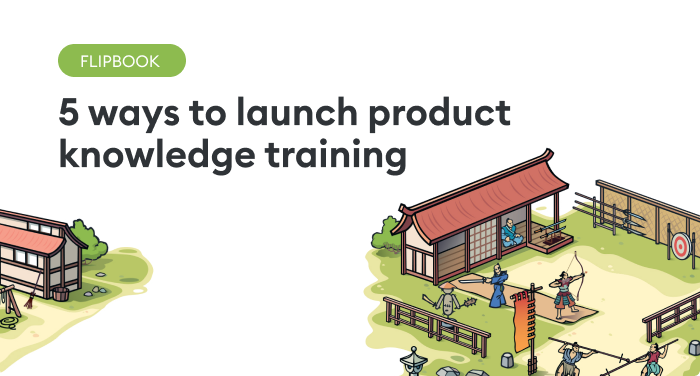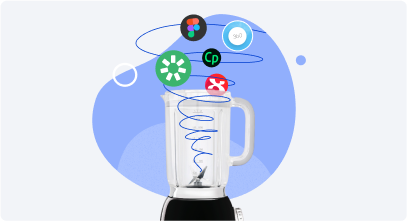How to Create Training Materials That Drive Employee Success

Employee training is the bread and butter of any organization. Without effective training, your business will suffer from skills gaps, low staff engagement, and performance issues. In contrast, regular and effective staff development can give it a competitive edge. From compliance training to onboarding, L&D teams need to create top-class employee training materials in a timely manner. This is no easy feat, especially in a fast-paced corporate setting. Fortunately, the right tools and preparation can take the headache out of this.
Whether you’re an L&D sage of Yoda-like stature or a training newbie still learning the ropes, in this article, we’ll tell you everything you need to know about developing training materials.
- A training material explained
- A step-by-step guide to creating training materials
- Examples of training materials
- FAQ on creating eLearning content
What Are Training Materials?
Training materials are the core elements of any training program. Essentially, they are the contents that comprise it.
Training materials can come in many different formats, including digital or printed items. Each piece of content has a specific learning goal or desired outcome. Thus, they are usually combined to create a program or learning path. We’ll explore the main kinds of employee training materials later in this article.
How to Create Training Materials for Employees
Creating training content can seem daunting. Not only does it need to be engaging and effective, but it has to keep up with the needs and goals of the business. Building training materials in house allows L&D professionals to adapt to business changes and keep training up to date.
Here’s a step-by-step guide to the content development process.
Step 1. Define objectives
The first step is to set clear learning goals and objectives. Defining objectives for each training material will ensure that it achieves the desired learning outcome. Plus, it makes it easier to remove irrelevant content, thereby streamlining the creation process.
When it comes to establishing an objective for your training material, consider the following questions:
- Who is your audience?
- What business goal is the training material related to?
- What skills gap are you trying to fill?
- What is the desired learning outcome?
It’s important to establish concrete answers to these questions before you begin writing the content. The answers will act as a North Star, guiding you through the entire training material development process and keeping your objectives in sight.
Step 2. Review existing training material
Next, get to know the learning content that’s currently available. An up-to-date inventory of all existing content will create opportunities for you to reuse, repurpose, or redo training material. This will save you valuable time and resources, and enable you to pinpoint training gaps.
Keep an eye out for outdated material, issues with the training content, and inaccuracies. The best way to determine the effectiveness of the material is to gather feedback about how it performed. This information will help you build more effective content in a shorter time frame.
To evaluate current training content properly, ask these questions:
- How is training currently being conducted?
- What (if any) training materials do we currently have on this topic?
- What type of training resources are they (videos, training manuals, presentation decks, etc.)?
- Is all relevant information covered in the current materials?
- Is the training content outdated?
- Are there any mistakes or are major changes needed?
- Are the training materials engaging and didactic?
- How successful was the previous training? What needs to be improved?
Step 3. Design a training plan
It’s now time to devise a training plan that is an outline of all the learning content you will create and how it all fits together. It’s an essential part of the development process, providing a bird’s-eye view of all training activities and resources in the business.
Start off with a general outline. Think of it like a jigsaw puzzle: at this stage, you simply want to understand how everything fits together to see the big picture. This could be as simple as a spreadsheet documenting all employee training programs and the corresponding training materials for each one. Here’s a sample sales training plan for new hires:
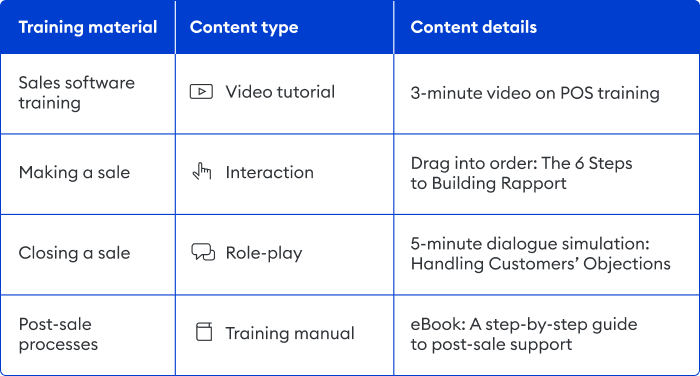
Step 4. Choose an authoring tool
Now let’s turn our attention to how to develop training materials. For most types of eLearning materials, you’ll need a content authoring tool. It helps you create digital training materials and convert them into an eLearning format. This could take the form of online courses, assessments, video lectures, role-plays, etc.
With iSpring Suite, you can create compelling training material for every type of learning scenario. From role-play simulations to interactive quizzes, it comes with a range of templates to help kick-start the development process. As a PowerPoint-based tool, first-time authors can pick it up in minutes. Moreover, there is an extensive built-in content library that provides over 89,000 preset slide templates, backgrounds, and characters to bring your training content to life in no time.
iSpring Suite
Fully-stocked eLearning authoring toolkit for PowerPoint. No training required to start!
Step 5. Create your training material
Once you have your outline and an authoring tool, you can get into the nitty-gritty. Zoom in and focus on each training material. At this stage, you should concentrate on the details, such as creating scripts for videos and developing outlines for quizzes and training manuals.
Writing training materials is enjoyable and rewarding, but there’s a lot to think about. Whether you’re a seasoned pro or a complete beginner, it’s always a good idea to start by creating a checklist of the entire creation process. This will prevent you from missing important steps.
Our comprehensive eLearning guide details how to create training material with iSpring Suite. It covers the nuts and bolts of the development process, so you can get started immediately.
Step 6. Test it in the field
Feedback is the best way to ensure your training materials are ready to be shared. Ideally, ask a group of testers from different areas of the company for their feedback. In this way, you will gain valuable insight from a range of perspectives and backgrounds.
Testing training content in the field will spotlight issues in the content, such as unclear language or information overload. To streamline the feedback process, ask testers the following questions:
- Is the learning material interesting and engaging?
- Is the content clear and easy to understand?
- Were there any points at which you felt confused? Please elaborate.
- Did you find the training content relevant to your daily work?
- Did the training offer you opportunities to apply what you learned?
- How can the training material be improved?
Step 7. Deliver the training material
Congratulations, you now know how to create training materials! But, there’s still the small matter of delivering your content. That’s where a learning management system (LMS) comes in.
An LMS is an essential eLearning tool that allows you to deliver, manage, and track employee training. All you have to do is upload your training material, organize it into a course or learning path, and assign it to the correct audience. What’s more, L&D professionals can automate all training management tasks through the LMS to save valuable time and resources.
With the iSpring Learn LMS, you can upload all types of training materials to build online courses or personalized learning tracks. The robust reporting feature allows you to extract custom reports to track learner activity and monitor training outcomes. Moreover, the mobile app gives employees the freedom to learn whenever and wherever they want.
iSpring Learn LMS
Automate corporate training and improve employee performance.
Examples of Training Materials
With so many options, it can be tough to choose the best content type. To inspire you, we’ve rounded up examples of some of our favorite training materials (all made using iSpring Suite).
1. Online courses
An online course is a self-paced training program delivered via digital resources. It’s usually made up of different training materials that all connect together to train learners on a topic. These training modules could include slides with text, multimedia, interactions, and quizzes.
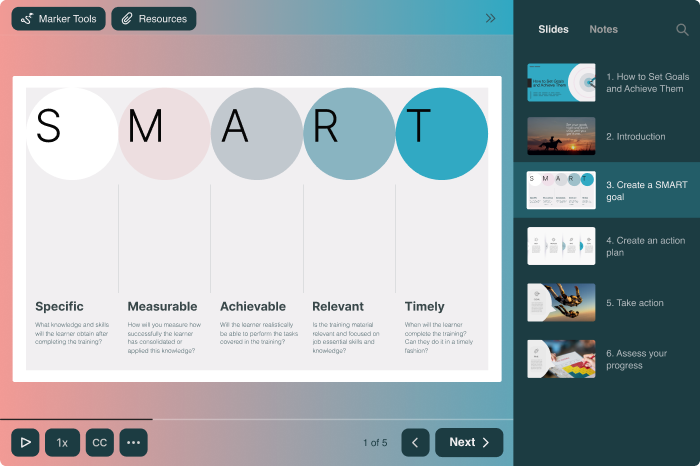
Use cases
Online courses are often used in corporate training to onboard new employees, deliver compliance training, or as parts of continuous training programs. They are particularly useful if your organization:
- Has existing training materials, such as PDFs, presentations, and job aids that you want to transform into an online course
- Is rolling out a new product or service and needs to train staff quickly
- Wants to automate or scale employee onboarding
- Needs to move training online on a time crunch
How iSpring can help
There are two things that you want to avoid when creating online courses:
- Boring your learners with dull impersonal content
- Spending too much time on the creation process
iSpring can help you sidestep both of these pitfalls. Avoid dull online courses by adding interactive elements to your slide content in iSpring. You simply need to import your existing training materials and inject some life with animations, transitions, multimedia, and interactive exercises.
To add a personal touch and evoke an emotional connection between the learner and the course, iSpring Suite allows you to create custom characters and add them to your slides. Make them appear to be related to the course topic, provide a storytelling atmosphere, and they can accompany the learner throughout the course, creating an effect of actual communication.
The simple PowerPoint-based interface makes it quick and easy to build captivating courses with no previous experience. Here’s an example of an engaging online slide-based course made using the iSpring authoring tool.
2. Quizzes
Quizzes (assessments) are key in eLearning. They not only allow you to check learners’ knowledge, but they are also interactive and show learners their progress. This breaks up the monotony of the training and encourages learners to actively participate. Plus, we all pay more attention when we know a test is coming.
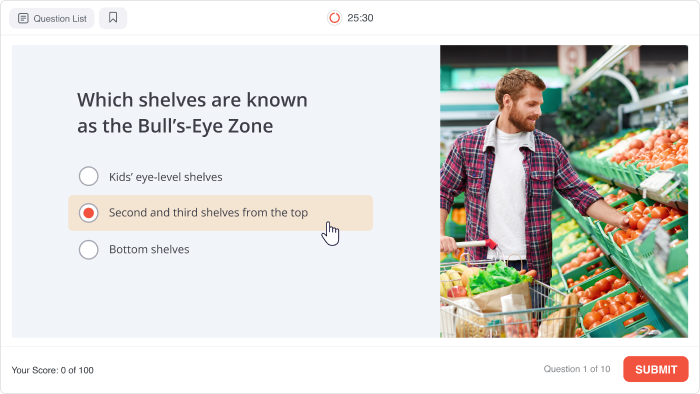
Use cases
Quizzes and assessments can be used in a number of ways. You can sprinkle them throughout an online course to check learners’ knowledge regularly or add a large quiz as a formal final assessment. In short, a quiz can be added at different stages of a training to reinforce learning and engage users.
How iSpring can help
In order for a quiz to be effective, it needs to ask the right questions. Many L&D professionals make the mistake of building a quiz with hundreds of multiple-choice questions. While there’s absolutely nothing wrong with multiple-choice, quiz questions should be varied to keep learners’ interest.
iSpring Suite has a rich in-built quiz maker with 14 different question types, allowing you to pick the best question type for each training scenario, such as fill-in-the-blanks, sorting items, and hotspot questions. The powerful quiz feature ensures that you really challenge learners and put them in real-life situations throughout the assessment.
This merchandising quiz encourages learners to interact, matching definitions and dragging merchandise to the correct shelf.
3. Training videos
Training videos engage learners more than any other content type. They are short videos that educate employees on a wide range of topics.

Use cases
Videos can be used as standalone learning content or embedded in online courses, making them a flexible option for employee training. Plus, there are several types of video content to choose from, including:
- Lecture captures – recordings of live training sessions or presentations
- Software tutorials – capture the instructor’s computer screen as they demonstrate how to use software
- Talking head videos – usually webcam recordings of an instructor explaining a training topic
How iSpring can help
Most L&D teams are not video editing professionals. Therefore, they require simple-to-use editing software that won’t compromise the quality of the final product. iSpring Suite comes with a built-in video studio that can create a range of professional-grade training videos, even if they’re used by those with no experience. You can easily build both talking head videos and record screencasts. Moreover, there is a wide selection of editing options to polish your videos and add a personal touch.
4. Role-plays
Role-play simulations put trainees in real-world scenarios, giving them a chance to practice in a risk-free environment. As such, they can build their confidence and develop their skills without impacting client relations. Most role-plays use branching scenarios to show the consequences of each decision. This teaches employees the outcomes of their actions in a safe space, propelling the learning curve.

Read also: Role-play Scenarios for Customer Service Training
Use cases
Role-plays are perfect for training on:
- Sales
- Customer service
- Negotiation
- Other client-facing situations that call for a one-to-one interaction
How iSpring can help
Creating training materials such as branching role-plays can be complicated. However, iSpring Suite allows the building of simulations with no technical experience required. The iSpring Content Library boasts a diverse range of characters and locations, making it easy to create engaging simulations in a snap and fully personalize your training.
Here is a great example of how to train sales staff using real-life scenario-based training.
5. Flipbooks
Flipbooks are an excellent and underused training tool. They are essentially eLearning longreads that are created by converting training materials that are in PDF, Word, or PowerPoint files into eLearning courses. That way, you can upload them to your LMS and track how many employees have studied them. They’re a great way to transform existing training documents into digital training content, making underutilized corporate documents accessible to employees.
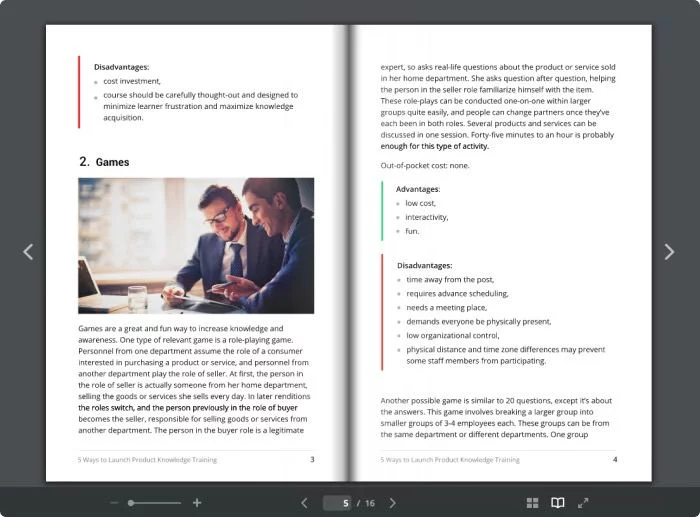
Use cases
Flipbooks are a great way to move training manuals online and train employees on:
- Department policies
- Standard operating procedures
- Step-by-step processes
How iSpring can help
iSpring Suite comes with an in-built tool that converts documents into interactive digital flipbooks that are responsive on all devices.
Here’s an example of a flipbook made with iSpring Flip on the basics of product knowledge training.
FAQ
Here are the most frequently asked questions on how to create training materials for eLearning.
1. What tools do I need in order to develop digital training content and share it with employees?
You need two tools:
- A content authoring tool to build training materials, such as online courses, interactive units, quizzes, and role-plays.
- A learning management system (LMS) to store, deliver, and manage training materials. This will also allow you to track learner progress through detailed analytics and reports.
2. What are some common types of training materials?
Training materials can include everything from paper handouts to AI-powered job simulations. In the context of eLearning, the most common types of training content include:
- Online courses
- Videos
- Assessments
- Role-plays
- Digital job aids
3. Are there any best practices when writing training materials?
Yes, there are some golden rules when developing instructional training material. Here are a few of our favorite tips to make content as engaging as possible:
- Write for your audience, their job role, and level of expertise
- Use examples and storytelling to clarify complex topics
- Utilize scenario-based learning to train on real-life job situations
- Write in short, simple sentences; avoid jargon
- Break training material up into small, digestible chunks
- Use visual aids to make content more appealing
In Closing
We hope these fundamentals of creating training material provide the know-how and inspiration to build more effective eLearning content. If you still haven’t tried iSpring Suite, start your 14-day free trial today. It will let you build compelling training courses in no time.






